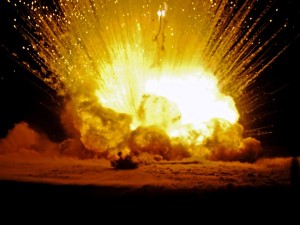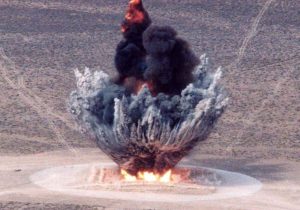
What causes chemical explosions?
Many are a result of oxidation reduction reactions. One or more reactants are oxidized. One or more are reduced. It should be recognized that not every such reaction results in explosion.
Iron combines with moist air to produce rust. The oxygen in the air is reduced. The iron is oxidized. Still, there is no “Kaboom!”
Chemical Explosions
Gunpowder is a mixture of potassium nitrate, carbon, and sulfur. Mixtures of these chemicals (in the correct ratios) can produce a chemical explosion. The potassium nitrate is reduced. The carbon and sulfur are oxidized.
What initiates such a controlled oxidation reduction reaction? Some energy stimulus such as a mechanical shock, a flame, or an electric spark touches it off. But what factors convert a sometimes simple reaction into an explosion?
 Factors 1 & 2
Factors 1 & 2
The first factor is reaction speed. The speed must be instantaneous! For the example of rust, given above, the rate of reaction is very slow. For gunpowder, it is sudden.
The second factor is “product-to-reactant” volume increase. An explosion requires reaction volume increases tremendously. Converting solid or liquid reactants into gas does the trick. This represents a huge expansion ratio! And expansion results in a pressure increase.
For instance, water’s molecular weight is 18. The volume of eighteen grams of water is very slight. Convert it to vapor however, and it occupies 22.4 liters—the better part of a cubic foot.
Intensifying Factor 2
An even stronger explosion results if many reactants convert to gas form. The total expansion is multiplied. For gunpowder, mentioned above, the reaction equation is:
10 KNO₃ + 3 S + 8 C → 2 K₂CO₃ + 3 K₂SO₄ + 6 CO₂↑ + 5 N₂↑
You will notice that there are two gaseous products. Reacting 10 moles of nitrate with 3 of sulfur and 8 of carbon (which takes up little volume) produces 11 x 22.4 moles, or 246 liters of gas!
Factor 3
A strong casing enhances explosion. Thus, a modern-day firecracker is tightly wrapped in paper. If the wrapping is not tight, the reaction may result in only a fizzle, producing a loud hiss. The firecracker is a “dud.” If the wrapping was done properly, the firecracker blows all at once, Ker-POW!
Did You Know?
Sometimes a single substance oxidizes and reduces itself. One example is nitroglycerine. The reaction is:
4 C₃H₅(ONO₂)₃ → 12 CO₂↑+10 H₂O↑+ 6 N₂↑+ O₂↑
Yes, even the water is gaseous (steam), due to the extreme heat of reaction.
Note: You might also enjoy: Nitrogen Tri-Iodide: A Schoolboy Explosive?
References:

That was good.
I thank you, John. I rather hoped it would be considered so…
The combustion equation for black powder is more likely to yield 12 CO instead of 6 CO2 by using 16 moles of C, and would provide a greater volume of gas. This gives weight ratios of reactants closer to the currently accepted optimum of 75% potassium nitrate, 10% sulfur, and 15% charcoal. This ratio also has a slight excess of S which may account for the sulfur smell and the reddish teardrops observed when a black powder firearm is discharged.
I suppose there are any number of ways to balance this. Assuming carbon monoxide sounds somewhat reasonable, though not 100% CO. Probably a mixture of CO and CO2. Here’s another way, for instance, although it plays a bit of havoc with your percentages, it postulates all CO. 2 KNO3 + S + 2 C → K2SO4 + N2 + 2 CO.